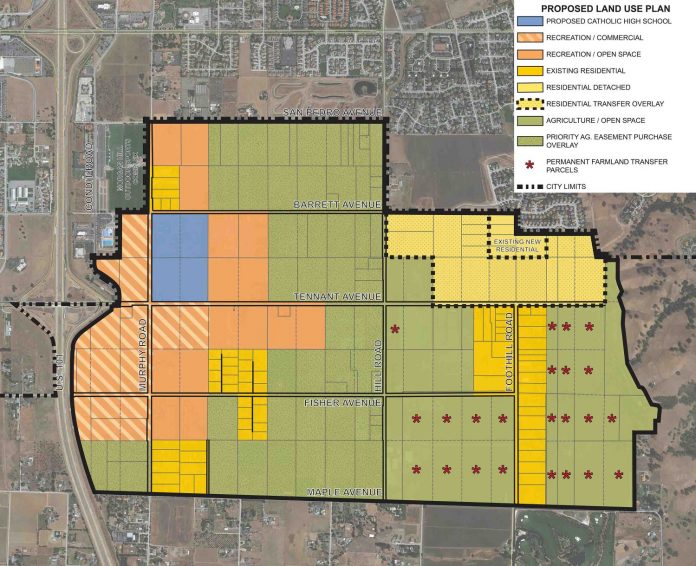
One of the keys to the City of Morgan Hill’s agricultural preservation program, which proposes to permanently preserve hundreds of acres of prime farmland in its current state in the Southeast Quadrant, is a Transfer of Development Rights concept in the area east of Hill Road.
This idea, which would require the approval of Santa Clara County before it becomes a reality, would allow the Chiala family to permanently transfer about 230 acres of active farmland of its building rights to roughly 60 acres—also currently used for agriculture—on property closer to the city limits between Tennant Avenue, Bill Chiala explained during a tour of the property one recent afternoon.
Thus, within about six to 10 years on the north side of Tennant Avenue past Hill Road would be about 160 homes, with the housing density becoming tighter as the development gets closer to the city limits on Barrett Avenue. On the south side of Tennant would forever remain farmland, which would be guaranteed “immediately” upon any future county approval of the plan.
“We’re preserving agriculture at a four-to-one ratio, which is unheard of,” said Chiala, noting that existing TDR programs in California only preserve farmland at a one-to-one or, at most, a two-to-one ratio.
But first, the City of Morgan Hill has to convince the Santa Clara County Local Agency Formation Commission (LAFCO) to approve its Southeast Quadrant Sports-Recreation-Leisure plan, which would extend the city’s Urban Service Area around 229 acres closer to U.S. 101. This proposal would allow developers to build sports fields, supporting commercial uses and a Catholic High School on the existing prime farmland, while requiring them to pay a mitigation fee that would help establish permanent agricultural easements farther east in the SEQ. These easements would be supplemented by the city’s open space fund, which currently has about $6 million.
LAFCO staff has recommended that the board deny the SEQ project at the March 11 meeting, and their report also decries the conceptual TDR program as promoting urban sprawl in the rural area.
Among the critics of the SEQ and the TDR program are open space advocates, including the Santa Clara County Open Space Authority.
The OSA’s Executive Director Andrea Mackenzie noted that the Chialas’ TDR proposal is “not fully fleshed out” in its infancy, adding to what she sees as its ineffectiveness in achieving meaningful ag preservation. But she criticized the plan for proposing housing development on prime farmland.
“In almost all instances (in other TDR programs), the development rights transfer from unincorporated land to a city, not moving rights around from one unincorporated property to another,” Mackenzie said. The county does not yet have a TDR program.
City staff, Chiala and other proponents of the city’s ag preservation plan say that’s not possible in Morgan Hill because vacant land within the city limits is too costly or too densely zoned to receive more development rights, and the prices are only getting higher. Transferring building rights inside the city limits could force the city to contribute from a limited supply of public funds, Chiala said.
“Ours is fairly simple because we own the sending site and the receiving site,” Chiala said. “It keeps the funds the city needs to buy easements (elsewhere in the SEQ), so there is no impact to the city.”
At the crux of OSA’s argument against the proposed Morgan Hill SEQ and TDR program is the agency thinks a regional strategy is the best way to preserve agriculture, with the county and the cities of Morgan Hill, Gilroy and San Jose working together, for example. In 2015, the county received a $100,000 Sustainable Agricultural Lands Conservation grant to develop a regional plan to preserve farmland on the urban edges of South County.
By 2017, with this framework, the county could become eligible for a portion of $40 million of state “cap and trade” funds devoted to ag preservation as a way to combat urban sprawl and reduce carbon emissions.
“Santa Clara County farmland is a regional resource for all current and future residents,” Mackenzie said. “Piecemeal legislation (such as the city’s SEQ plan) is not a feasible way to go. It doesn’t add up to a holistic approach that makes sense for southern Santa Clara County. We need a regional approach that works more comprehensively.”
The Chiala family has owned the agricultural land on which the TDR program is proposed since 1955, Chiala said. The family and their company, Chiala Farms, have grown crops on the vast majority of it—or leased it to other growers—since then. Another part of their TDR/ag preservation plan is to develop an agricultural resource and education center in the SEQ, which would include a “culinary center/community garden” that could be used by smaller farmers and hobby growers, Chiala explained.
Stripping the development rights from the Chialas’ agricultural property as they have proposed would drastically reduce the financial value of the properties, which are currently worth more than $100,000 per acre, according to real estate broker John Telfer, who represents the Chiala family.
Both opponents and supporters of City Hall’s and the Chialas’ plan agree the status quo will not preserve agriculture. Within the approximately 1,200-acre SEQ are more than 100 “underlying lots of record” created by the county in the late 1800s. These lots are between 5 and 10 acres in size, and right now each could be developed with a single family home and no requirement for the builder to mitigate the lost agriculture.
“Part of the regional framework has to look at what can the county do to stem (the current rate of ag loss) without taking away people’s property rights. That’s where more comprehensive thinking should be about how to incentivize landowners,” Mackenzie said.
Timing is critical for SEQ supporters however. The city’s SEQ and sports/recreation plan has been in the works for more than 10 years.
“We think we have a unique project here, but there’s a very narrow window of time,” Chiala said.







